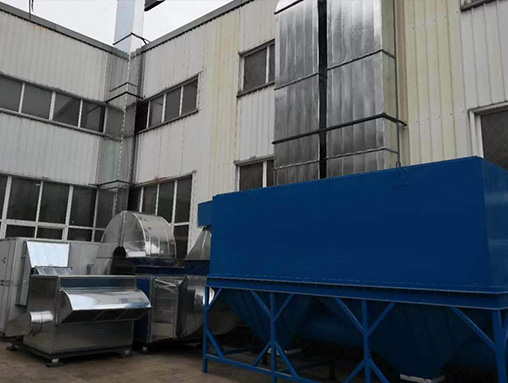bag-type dust collector
The technical characteristics of bag filter are that the number of dust concentrations in the gas at the outlet of the filter is within 10mg/m2, which has a high resolution for sub micron particle size fine dust and a wide processing range. It is used for flue gas dust removal in industrial furnaces, reducing the emission of air pollution. It is insensitive to the characteristics of dust and is not affected by dust and resistance. When using filter materials such as glass fiber, P84, and polytetrafluoroethylene, it can be carried out at temperatures above 200 ℃. The structure is simple, easy to maintain, and the cost is lower than that of electrostatic precipitators under the same dust removal efficiency.
When dusty gas passes through the filter material, the dust is trapped on its surface, and clean air is discharged through the gaps of the filter material. Air filtration technology is the basic principle of bag filters. At present, the main methods used for air filtration are fiber filtration, membrane filtration (film or membrane), and dust layer filtration. All three methods can achieve the goal of separating solid particles from aerosols, but their separation mechanisms are different. The structure of a bag filter mainly consists of upper, middle, lower parts, cleaning system, and ash discharge mechanism. The performance of a bag filter is not only determined by the correct selection of bag materials, but also by the crucial role played by the dust cleaning system.
The working principle of bag filter:
The dusty gas enters the filtering chamber from the lower collection hopper (or lower open flange), and coarse particles directly fall into the collection hopper (or silo). Fine particle dust rises to the surface of the filter bag with the airflow, and after filtration, the dust is trapped on the surface of the filter bag. The purified gas enters the clean room through the bag mouth and is discharged into the atmosphere by the system induced draft fan. As the filtration process continues, the accumulation of dust on the surface of the filter bag increases, causing the equipment resistance to rise to the set value (usually 1200Pa). The time relay (or micro differential pressure controller) outputs a signal, and the programmable controller starts to work. The pulse valve is opened in sequence, allowing high-pressure compressed air to be instantly and rapidly sprayed into the filter bag through the nozzle of the blowing tube. The high-speed reverse airflow causes the filter bag to suddenly expand, and the dust attached to the bag surface falls off and falls into the collection hopper (or bin). Dust is discharged by a flap valve or ash unloading mechanism.
Glass lifter stamping parts series
Light Truck Blocker Series
New Energy Sheet Metal Parts Series
New energy vehicle parking bracket series
Dust collector series
 Analysis and Application of Stamping Parts and Precautions for Mold Forging
Analysis and Application of Stamping Parts and Precautions for Mold ForgingTo deal with problems caused by materials, manufacturing personnel can choose appropriate p...
 Key points of mold and tooling management for metal stamping equipment and mold
Key points of mold and tooling management for metal stamping equipment and moldRegular maintenance is implemented for tooling molds, and a mandatory pre repair system is ...
 Factors affecting the management of production materials and defects in stamping
Factors affecting the management of production materials and defects in stampingStrengthen the control and supervision of incoming stamping parts. For the stamping worksho...
 Modernization process upgrade and quality process monitoring management of metal
Modernization process upgrade and quality process monitoring management of metalThe manufacturing process level of chassis stamping parts in automobile production not only...
 Quality improvement measures and reasonable selection of equipment for metal sta
Quality improvement measures and reasonable selection of equipment for metal staStamping technology can be divided into two categories: separation process and forming proc...


